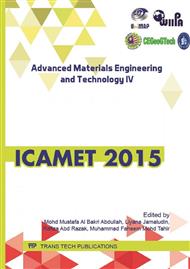p.63
p.68
p.73
p.76
p.79
p.83
p.87
p.93
p.101
Mechanical Interlocking on Leadframe Surface for Bondability of Au Wedge Bond
Abstract:
This work is a contribution towards the understanding of wire bond integrity and reliability in relation to their microstructural and mechanical properties in semiconductor packaging.The effect of surface roughness and hardness of leadframe on the bondability of Au wedge bond still requires detail analysis. Two type of leadframes namely leadframe A and leadframe B were chosen and scanning electron microscope (SEM) and optical microscope were used to inspect the surface morphology of leadframes and the quality of created Au wedge bond after wire bonding process. It was found that there were significant differences in the surface morphologies between these two leadframes. The atomic force microscopy (AFM) which was utilized to measure the average roughness, Ra of lead finger confirms that leadframe A has the highest Ra with value of 166.46 nm compared to that of leadframe B with value of 85.89 nm. While hardness value of different lead finger from the selected leadframe A and B obtained using Vicker microhardness tester are 180.9 VH and 154.2VH respectively.
Info:
Periodical:
Pages:
79-82
Citation:
Online since:
May 2016
Authors:
Keywords:
Price:
Сopyright:
© 2016 Trans Tech Publications Ltd. All Rights Reserved
Share:
Citation:


